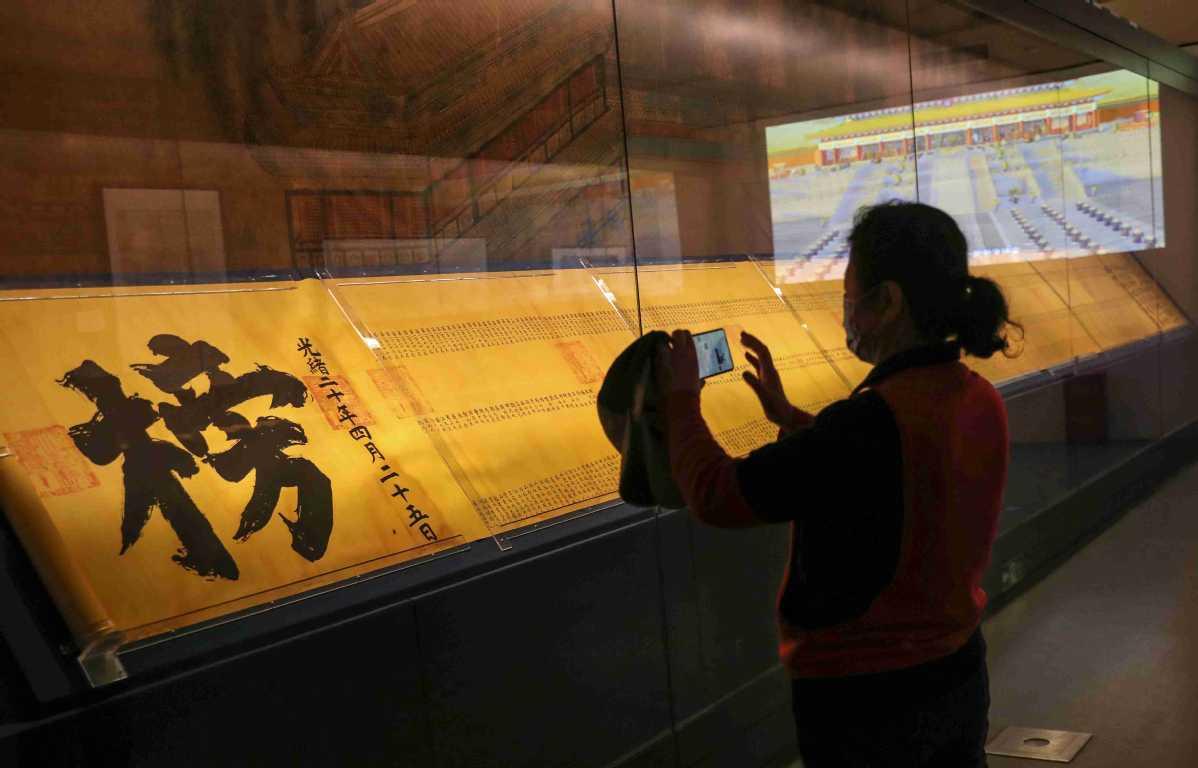Nation's greatest ancient literary artifacts, manuscripts go on display
 0 Comment(s)
0 Comment(s) Print
Print E-mail Xinhua, February 16, 2023
E-mail Xinhua, February 16, 2023

A visitor photographs a scroll at a National Museum of Classic Books exhibition of literary artifacts in Beijing on Wednesday. The displays bring together 382 cultural relics. [Zou Hong/China Daily]
Some of China's greatest ancient literary artifacts and manuscripts have been put on display at Beijing's National Museum of Classic Books, offering a rare insight into the development of the country's writing system and culture.
The exhibitions include the "four great discoveries" of the early 20th century in ancient literary artifacts: jiaguwen, or oracle-bone inscriptions, the oldest-known Chinese writing system; the Dunhuang manuscripts, religious documents produced between the 4th and 11th centuries found in the Mogao Caves, Gansu province, in 1900; inscribed wooden and bamboo slips excavated from the Juyan area at the juncture of Inner Mongolia autonomous region and Gansu province; and files stored at the Imperial Cabinet Repository of the Ming (1368-1644) and Qing (1644-1911) dynasties.
Gu Heng, curator of the exhibitions, said they systematically show the development of Chinese writing.
"From oracle bones dating back 3,000 years, to wooden slips, and then paper, we can see changes in where people wrote, and changes in styles of writing, from jiaguwen to zhuanshu (seal script) and lishu (clerical script). The changes in Chinese writing reflect the development of Chinese civilization," Gu said.
The opportunity to see such grand exhibitions of ancient literature is rare, Gu said. The items are fragile and have different temperature, humidity and lighting requirements when it comes to their preservation. Curators have provided tailored environments for each exhibition.
While many of the cultural relics and manuscripts have been exhibited in small displays or individually in museums in China and other countries, it is the first time the "four great discoveries" of the early 20th century in ancient literary artifacts have been exhibited under one roof.
Organized by the National Library of China, Dunhuang Academy, the First Historical Archives of China and Gansu Bamboo Slips Museum, the exhibitions opened in Beijing on Wednesday.
According to Xiong Yuanming, director of the National Library of China, the exhibitions cover an area of 0.3 hectares and showcase 382 items including oracle bones, Juyan slips, Dunhuang manuscripts and files from the Ming and Qing dynasties.
"We want to explain the historical manuscripts from an academic perspective, explore their value, showcase them in a creative manner, and tell the stories behind them," Xiong said, adding it will help illustrate their "irreplaceable role" as "carriers of history and culture, in the inheritance of Chinese civilization".
Visitors to the exhibitions can also learn about historical figures who played important roles in discovering or collecting the literature, and see original literature and important cultural relics related to them.
Highlights of the exhibitions include oracle bone No 2174, which records an emperor of the Shang Dynasty (c. 16th century-11th century BC) hunting elks and rabbits. Since jiaguwen is a pictographic script, the legs and short tail of a rabbit are vividly shown on the bone.
Golden Lists of successful candidates in the Qing Dynasty imperial examinations to choose civil servants during the reign of emperors Qianlong (1711-99) and Guangxu (1871-1908) are displayed in the Ming and Qing files exhibition, and relate details of keju, the ancient imperial examination system at that time.
The lists show the names, rankings and hometown of the chosen candidates on yellow sheets of two sizes. The smaller one was for the emperor to view, while the bigger one was put on display on the street to announce the result to the public. Golden Lists were added to UNESCO's Memory of the World Register in 2005.
The museum has cooperated with tech company ByteDance to add virtual reality technology to the exhibitions. By wearing VR glasses, an immersive experience is offered to visitors, allowing them to talk with ancient people, learn to make oracle bones and how to operate ancient astronomy instruments
The exhibitions are expected to run until April in Beijing, and then move to other cities in China, Gu said.






Go to Forum >>0 Comment(s)